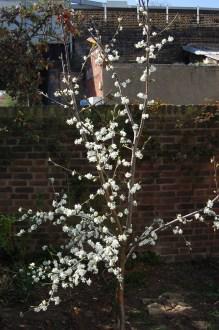
Prunus domestica 'Victoria' Flowers (07/04/2012, London)
Position: Full sun
Flowering period: Spring
Soil: Moist, well drained
Eventual Height: 6m
Eventual Spread: 6m
Hardiness: 4a – 9b
Family: Rosaceae
Prunus domestica ‘Victoria’ is a compact, deciduous fruiting Plumb tree. Its mid green leaves are simple, obtuse with mildly crenate margins and usually have nectaries on the leaf stalk. Its flower is white in colour, 5 petaled with five sepals, they give rise to numerous stamens and are borne racemes. The flowers are self fertile. Its edible red speckled fruit is a fleshy drupe, with a single relatively large hard coated seed. Its is usually grafted onto a dwarf root stock to form a smaller tree.
The species Prunus domestica is native to Europe. Prunus domestica ‘Victoria’, commonly known as Victoria Plum, was introduced in the 1840′s in Sussex, where it became popular as a commercial crop.

Prunus domestica 'Victoria' (07/04/2012, London)
The etymological root of the binomial name Prunus is the classical Latin name of the Plum tree. Domestica is derived from the Latin domesticus ’domestic’.
The landscape architect may find Prunus domestica ‘Victoria’ useful as a low growing fruiting tree. It would be suitable for community or allotment gardens.
Ecologically, P. domestica ‘Victoria’ is attractive to bees and pollinating insects.
The Royal Horticultural Society has given P. domestica ‘Victoria’ their prestigious Award of Garden Merit in 1993.
P. domestica ‘Victoria’ prefers moist, well-drained soils. It prefers a neutral pH of soil, it dislikes chalky.
P. domestica ‘Victoria’ requires little maintenance. Pruning should be carried out in summer to reduce the risk of Silver Leaf.

